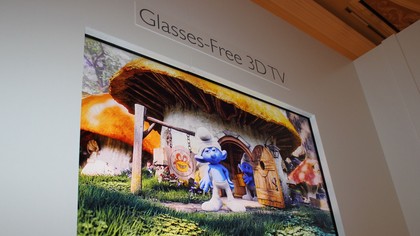Why you can trust TechRadar
We thought CES had forgotten all about 3D. Barely mentioned on any of the big manufacturers' stands in Las Vegas, it seems to have become the forgotten feature – until Philips brought it firmly back into the fray with its latest-gen glasses-free 3DTV.
Although it's experimented with auto-stereoscopic TVs before, this is the first generation of the concept using an Ultra HD panel – and, boy, does it make a difference.
Glimpsed in a private suite away from the buzz of the show floor, we managed to spend some time with a TV that uses its 4k resolution to create a Full HD glasses-free 3D image.
The key difference to the Toshiba ZL2 is detail. Bags of it. Standing 3.5m from the screen, it's first necessary to get in a position where you can see the 3D effect, though a small box on the screen helps; if it shows two blue lights, you need to move, one light and you're good to go. It's pretty obvious anyway, but it's a nice touch.
We were only able to watch animated fare, such as Yogi Bear, Coraline and Despicable Me, but it's good way to see how this clever-clogs TV performs one of its tricks; colours in the foreground are given a special intensity, though backgrounds remain sharp and in focus, too. There is a slight shimmer in some backgrounds, though there was no motion compensation processing at work. What there is, is some crosstalk compensation trickery at play – and it works a treat.

Remarkably there's little difference in sharpness when switching between 2D and 3D modes, with the image seeming to spin slightly on an axis during the transition. You can even switch to a special depth map mode to see exactly that's going on.
"It's actually the enabler for 2D-3D conversion, so there's a lot of potential here," Danny Tack, director Product Strategy and Planning at TP Vision, which owns the Philips brand, told TechRadar. If Philips can get live TV and archive sources to look good, it would almost be a done deal – and with that in mind there is a fixed lens, though it doesn't appear to affect the sharpness of 2D much.
Sign up for breaking news, reviews, opinion, top tech deals, and more.

"It's a 4k panel inside that has a particular lens design that's a unique TP Vision design that allows nine fractional views leading to over 100 views," says Tack. "That means there are 10-12 optimal positions to sit in a room and have your sweetspot in 3D." 3D can be seen from angles up to 120-degrees in from of the TV, and in our demo we were able to move our head at least 30cm either side without losing the 3D effect. Tack explains that the depths are going about 30cm in and out of the screen. "You always have to trade off the resolution and the depth," he says. "You could make more depth but we would then have to go under Full HD."

Although the prototype we witnessed in action measured 60-inches, it's possible that market-ready models could be smaller. "This is the minimum size for a 4k Ultra HD TV, but for this product you need the 4k for the 3D to work best," said Tack "You could go to smaller screen sizes – say, to 46-inch – because you don't need the 4k performance for 2D viewing."
That makes a lot of sense since it's unlikely that any owners of this TV would ever want to watch anything in 2D.
"We haven't decided when to launch it," says Tack. "I was looking towards CES to see if there was a growing momentum, but we're well on our way for launching."
Prices and sizes are TBC, too, but don't expect Philips' impressive effort to be alone when it does finally launch – behind-the-scenes at the CES the TV industry is gearing-up fore the re-birth of 3D.

Jamie is a freelance tech, travel and space journalist based in the UK. He’s been writing regularly for Techradar since it was launched in 2008 and also writes regularly for Forbes, The Telegraph, the South China Morning Post, Sky & Telescope and the Sky At Night magazine as well as other Future titles T3, Digital Camera World, All About Space and Space.com. He also edits two of his own websites, TravGear.com and WhenIsTheNextEclipse.com that reflect his obsession with travel gear and solar eclipse travel. He is the author of A Stargazing Program For Beginners (Springer, 2015),
What is a hands on review?
Hands on reviews' are a journalist's first impressions of a piece of kit based on spending some time with it. It may be just a few moments, or a few hours. The important thing is we have been able to play with it ourselves and can give you some sense of what it's like to use, even if it's only an embryonic view. For more information, see TechRadar's Reviews Guarantee.